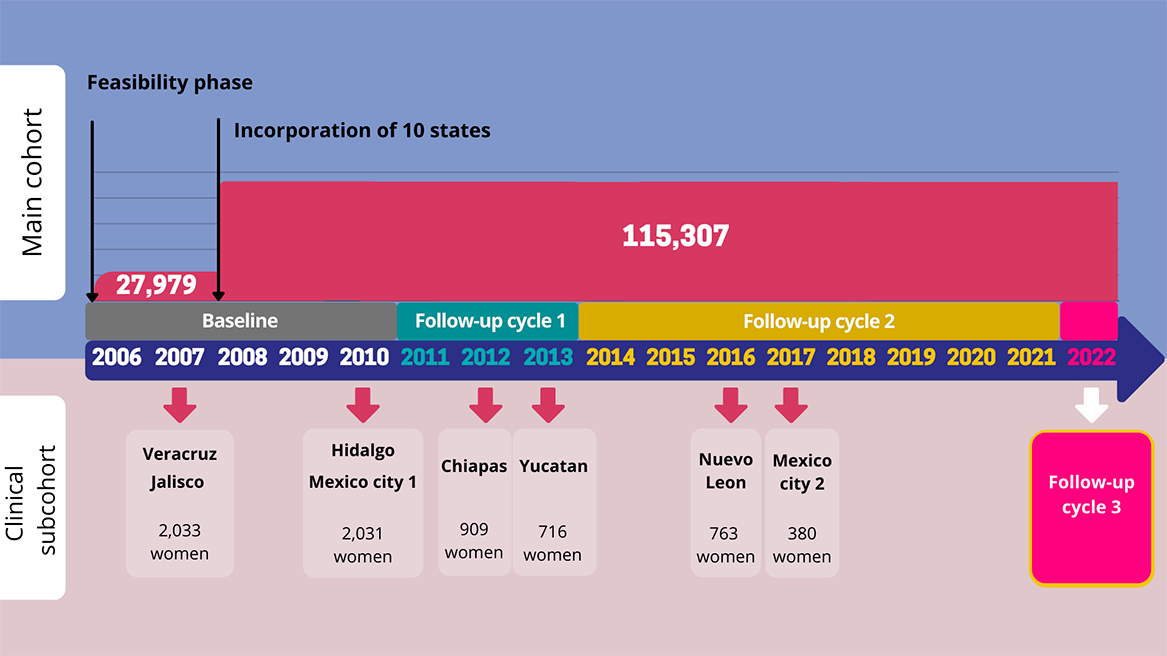Available MTC data
The Mexican Teachers’ Cohort (MTC) is a prospective observational study.
Over 15 years, cohort participants have completed self-reported lifestyle questionnaires and attended health assessments as part of the clinical subcohort.


Baseline and follow-up evaluation
In 2006 the MTC began the baseline evaluation in two states: Jalisco and Veracruz. This “feasibility evaluation” phase ended in 2007.
Between 2008 and 2010 the baseline evaluation was expanded to 10 more states: Baja California, Chiapas, Mexico City, Durango, Guanajuato, Hidalgo, Nuevo León, Sonora, Yucatán, and expanded the sample of Jalisco and Veracruz.
In 2011, the first follow-up cycle began for the entire cohort, with a response rate of 83%. The second general evaluation cycle began in 2014 and ends in 2021 with a response of 62%.
In 2022 we have started the third follow-up cycle of the cohort.

Summary of available MTC data by follow-up cycle
The data on risk factors and health conditions have been collected through the baseline and follow-up questionnaires. Below is a summary of the main groups of variables available per evaluation cycle.
Please refer to the questionnaires for detailed information.
To correctly display all the data, use your fingers to scroll sideways
Summary of data on health on risk factors and health conditions by follow-up cycle
| Year of evaluation Number of participants (n) | 2006 27,979 | 2008 106,456 | 2011 94,527 | 2014 69,970* | 2022 In progress |
|---|---|---|---|---|---|
| Body weight | |||||
| Physical activity | |||||
| Smoking status | |||||
| Diet (FFQ) | |||||
| Diet in adolescence | |||||
| Reproductive health | |||||
| Air pollution | |||||
| Migraine | |||||
| Medicines | |||||
| Depression (PHQ-9) | |||||
| Adverse childhood experiences (ACE) | |||||
| Sleep quality (PSQI) | |||||
| Perceived Stress Scale (PSS-4) | |||||
| Year of evaluation Number of participants (n) | 2006 27,979 | 2008 106,456 | 2011 94,527 | 2014 69,970* | 2022 In progress |
|---|---|---|---|---|---|
| Body weight | |||||
| Physical activity | |||||
| Smoking status | |||||
| Diet (FFQ) | |||||
| Diet in adolescence | |||||
| Reproductive health | |||||
| Air pollution | |||||
| Migraine | |||||
| Medicines | |||||
| Depression (PHQ-9) | |||||
| Adverse childhood experiences (ACE) | |||||
| Sleep quality (PSQI) | |||||
| Perceived Stress Scale (PSS-4) | |||||
Summary of data on health outcomes by follow-up cycle
| Year of evaluation Number of participants (n) | 2006 27,979 | 2008 106,456 | 2011 94,527 | 2014 69,970* | 2022 In progress |
|---|---|---|---|---|---|
| Severe acne | |||||
| Alzheimer's Disease | |||||
| Rheumatoid arthritis | |||||
| Asthma | |||||
| Stroke | |||||
| Cervical cancer | |||||
| Breast cancer | |||||
| Other cancer | |||||
| Cataracts | |||||
| Depression | |||||
| Diabetes | |||||
| Gestational diabetes/preeclampsia | |||||
| Liver disease or cirrhosis | |||||
| Kidney disease | |||||
| Thyroid disease | |||||
| COPD | |||||
| Multiple sclerosis | |||||
| Hip fracture | |||||
| Hepatitis B o C | |||||
| Hypercholesterolemia | |||||
| Hypertension | |||||
| Heart attack | |||||
| Migraine | |||||
| Polycystic ovary syndrome | |||||
| Parkinson's disease | |||||
| Gallstones | |||||
| Year of evaluation Number of participants (n) | 2006 27,979 | 2008 106,456 | 2011 94,527 | 2014 69,970* | 2022 In progress |
|---|---|---|---|---|---|
| Severe acne | |||||
| Alzheimer's Disease | |||||
| Rheumatoid arthritis | |||||
| Asthma | |||||
| Stroke | |||||
| Cervical cancer | |||||
| Breast cancer | |||||
| Other cancer | |||||
| Cataracts | |||||
| Depression | |||||
| Diabetes | |||||
| Gestational diabetes/preeclampsia | |||||
| Liver disease or cirrhosis | |||||
| Kidney disease | |||||
| Thyroid disease | |||||
| COPD | |||||
| Multiple sclerosis | |||||
| Hip fracture | |||||
| Hepatitis B o C | |||||
| Hypercholesterolemia | |||||
| Hypertension | |||||
| Heart attack | |||||
| Migraine | |||||
| Polycystic ovary syndrome | |||||
| Parkinson's disease | |||||
| Gallstones | |||||

Mortality
En Mortality es Causes of death up to 2019 (n=2,140)

Clinical subcohort and biobank
Based on the the clinical evaluations, the MTC clinical subcohort was formed.
The main areas that were evaluated during the clinical sessions are shown below. For more details, consult the questionnaires.
To correctly display all the data, use your fingers to scroll sideways
Clinical subcohort
| Veracruz | Jalisco | Hidalgo | CDMX-1 | Chiapas | Yucatán | Nuevo León | CDMX-2 | |
|---|---|---|---|---|---|---|---|---|
| Year Participants (n) | 2007 1,034 | 2007 999 | 2010 1,07 | 2010 961 | 2012 909 | 2013 716 | 2016 765 | 2017 380 |
| Anthropometry | ||||||||
| Physical activity | ||||||||
| Breast density | ||||||||
| Blood pressure | ||||||||
| VaSera | ||||||||
| Intima Media Thickness (IMT) | ||||||||
| Lipid profile | ||||||||
| Blood count | ||||||||
| Inflammation biomarkers | ||||||||
| Fatty acids | ||||||||
| Hair sample | ||||||||
| Veracruz | Jalisco | Hidalgo | CDMX-1 | Chiapas | Yucatán | Nuevo León | CDMX-2 | |
|---|---|---|---|---|---|---|---|---|
| Year Participants (n) | 2007 1,034 | 2007 999 | 2010 1,07 | 2010 961 | 2012 909 | 2013 716 | 2016 765 | 2017 380 |
| Anthropometry | ||||||||
| Physical activity | ||||||||
| Breast density | ||||||||
| Blood pressure | ||||||||
| VaSera | ||||||||
| Intima Media Thickness (IMT) | ||||||||
| Lipid profile | ||||||||
| Blood count | ||||||||
| Inflammation biomarkers | ||||||||
| Fatty acids | ||||||||
| Hair sample | ||||||||
The bank of biological samples is protected in the National Institute of Public Health.

